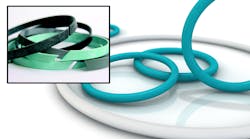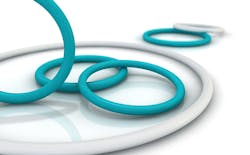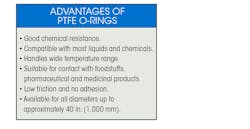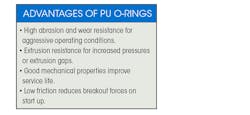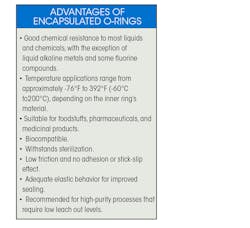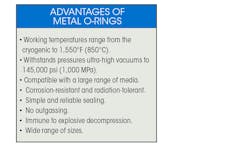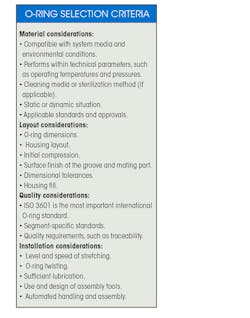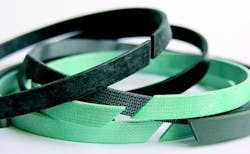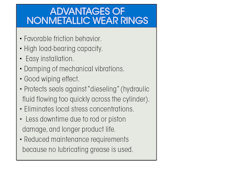What’s the Difference Between O-Rings and Guide Rings?
O-rings and guide rings are both used on hydraulic cylinders, but they handle different tasks. O-rings are often the first choice for engineers because of their flexibility and performance in static and semi-dynamic applications, and nearly every sealing configuration in hydraulic cylinders require wear rings. Ultimately, the application and its specifications determine if an O-ring or a guide ring should be used.
O-ring Basics
O-rings are used to seal all kinds of devices to keep them operating and safe. They do so by keeping necessary fluids in hydraulic systems and unwanted fluids and contaminants out. O-rings are inexpensive to make, can be used in a wide variety of applications and are easy to use; these traits have made O-rings the most widely used seal for hydraulic applications.
Before O-rings were invented, machine makers crafted seals and gaskets out of cloth, leather and animal guts. The first O-ring was patented in 1848 by British inventor Alonzo B. Woodcock. Nearly, a century later, in 1938, a U.S. patent filed by Danish-born machinist Niels Christensen initiated their widespread use.
Today, every industrial segment uses O-rings, ranging from individual seals for repairs and maintenance to energizing elements for polytetrafluoroethylene (PTFE) seals in hydraulics.
O-rings are fitted between two components as a primary or secondary seal. As the primary seal, O-rings typically seal in two directions. They are functional immediately after installation and they prevent leaks initially by compressing the O-ring with the hardware. System pressure then adds to and completes the total sealing force. As secondary seals, O-rings are part of a sealing system with a main seal that adds strength or media resistance.
The important O-ring dimensions are its inner diameter and cross section.
O-rings are predominantly primary seals in static sealing applications, and the direction of the sealing force defines the O-ring as either axial or radial. O-rings used as axial seals, which can have pressure applied from inside or outside the seal, are common in flanges and cover plates.
Radial seals are for inner sealing when the sealing surface is at the inside diameter of the O-ring, and outer sealing when the sealing surface is at the outside diameter of the O-ring. Piston and rod sealing applications often use radial seal O-rings.
O-rings are suitable for static sealing if the seal’s contact area remains stationary. They are also suitable for moderate dynamic sealing conditions if the sealing surface only moves or turns occasionally. In fully dynamic applications where the contact area moves, O-rings typically serve as energizing elements for a main seal that is often non-elastic but more wear-resistant, and offers lower friction properties.
O-rings are the most common seals and often an engineer’s first choice based on their flexibility and performance in static and semi-dynamic applications. Ultimately, the application and its specifications determine if an O-ring should be used.
As the demands of applications increase, so do the requirements for seals, meaning a single O-ring is often not enough. Hydraulic systems, for instance, usually contain several different types of seals, each with its own tasks. These seals invariably include O-rings, either with a static function or as an energizer for a PTFE or polyurethane (PU) seal. PTFE has outstanding low friction characteristics for dynamic applications, but no elasticity. Hence, the need for an energizer.
Seal Materials
The right choice of materials is essential in selecting the right seal for an application.
Elastomeric O-rings are double-acting, meaning they seal against pressurized media from both directions, for static and slow dynamic applications. They are available in a wide range of materials, including nitrile-butadiene rubber (NBR), fluoroelastomer (FKM), ethylene propylene diene rubber (EPDM), chloroprene, silicone (VMQ) and fluorosilicone (FVMQ). These materials conform to ISO 3601, AS568 and other recognized standards. (The advantages of elastomeric O-rings are listed in the table below.)
The downside of elastomeric O-rings is that in dynamic applications they add friction and tend to twist. They can also be difficult to assemble and install, which increases the risk of failures. And O-ring elastomer materials might not be compatible with the hydraulic fluid. O-ring materials must be compatible with the system, process and, where applicable, cleaning fluids that will be used on them.
PTFE O-rings are often specified if the chemical and thermal resistance of standard elastomer O-rings are not sufficient. PTFE is a partially crystalline thermoplastic with high thermal resistance and the highest chemical resistance of any plastic. PTFE is also inelastic, so PTFE O-rings are typically only recommended for static face seals or flange type configurations that are not actively engaged and disengaged. (The advantages of PTFE O-rings are listed in the table below.)
The downsides of using PTFE for O-rings are that it can only be stretched or compressed to a limited extent during installation, and it is incompatible with alkaline metals and some fluorine compounds. PTFE also tends to flow or creep under pressure.
Polyurethan (PU) O-rings have exceptionally high abrasion and extrusion resistance. They are suited for applications in which O-rings undergo dynamic loads. In many cases, PU O-rings are an alternative to NBR O-rings due to their high mechanical strength. (The advantages of elastomeric O-rings are listed in the table below.)
The downside of PU is that it does not resist esters, aromatics, chlorinated hydrocarbons and concentrated acids. It is also sensitive to water and moisture.
Encapsulated O-rings consist of an elastomeric inner ring and a seamless fluorinated ethylene propylene (FEP)/perfluoroalkoxy alkane (PFA) copolymer sheath that surrounds the elastomer ring. They are used when a standard elastomer O-ring’s chemical resistance is not sufficient. FEP/PFA-encapsulated O-rings are similar to PTFE O-rings. (The advantages of encapsulated O-rings are listed in the table below.)
The disadvantage of encapsulated O-rings is that they can only be stretched to a limited extent during installation. And their elastomer core limits the application’s maximum temperature.
Metal O-rings come in a wide range of materials. In static face-sealing applications, they provide reliable performance over a large temperature range in gases and liquids. Metal O-rings are also suited for extremely high pressures and vacuums. (The advantages of metal O-rings are listed in the table below.)
The downside of metal O-rings is that they are only suited to static applications, they often require significant installation forces and they can typically only be used in axial applications.
Selecting the Right O-ring
When selecting the type and size of O-ring, design teams should consider four criteria that will maximize seal life and minimize cost: the material, layout, quality and installation.
Engineering teams should tap knowledgeable suppliers for O-ring recommendations based on their experience. There are also several tools to help select and size O-rings, such as Trelleborg’s O-ring Calculator, Compatibility Guide and Sealing Solutions Configurator.
Wear Rings and Guide Rings
Wear rings, also known as guide rings, are used to guide moving components in hydraulic systems. In general, wear rings extend the life of a hydraulic system and can be replaced faster and less expensively than an entire cylinder. They also increase equipment availability and up-time, which is critically important in the fluid power industry.
In hydraulic cylinders, wear rings typically support the piston or rod to help guide movement and optimize seal performance. They can handle radial loads and prevent contact between the piston and bore or rod and cylinder head. They also act as wear components.
Choosing the best material for a wear ring is a matter of evaluating the application, the size of the load within the system, the installation space and the mating surface.
Wear rings can be metallic or nonmetallic. Metal versions are appropriate in some applications, but nonmetallic wear rings offer several benefits for hydraulic cylinders in fluid-power applications such as off-highway, material handling, industrial machines, mobile hydraulics, and agricultural equipment. Nonmetallic wear ring materials include PTFE-based compounds, as well as thermoset plastics and thermoset options.
PTFE-based wear rings provide extremely low friction within hydraulic systems and are particularly well-suited to dry-running applications when mated with steel, aluminum or cast iron. Their smoothness generates so little abrasion that, in some cases, they allow the use of less expensive hardware in the system.
The low friction of PTFE-based wear rings reduces the risk of stick-slip when starting up the system. As a result, PTFE wear rings are commonly used in equipment operating at high temperatures and pressures.
Thermoset wear rings have outstanding wear resistance properties and are strong, light and durable, letting them offset heavy loads at low speeds. Although thermoset wear rings are dense, they are elastic compared to metal rings.
Thermoplastic wear rings, the workhorses of hydraulic systems, are commonly used in internal valves and compressors. They are temperature-resistant and can provide a high level of performance at a more affordable price than PTFE-or thermoset wear rings. Most thermoplastic wear rings can mate with steel, hard chrome-plated surfaces and cast iron. (The advantages of nonmetallic wear rings are listed in the table below.)
Tolerance is the most critical criteria for design teams specifying wear rings. Molded, high-volume, commercial wear rings can have wide tolerances, typically up to 0.005 in. of the total wall thickness. Precision machined wear rings have tighter specifications and lower tolerance stacks. Though they cost more, these wear rings offer a lower total cost of ownership because they fit better between parts and reduce the risk of premature seal and system failures. This is critical for system performance and longevity.
It is also important that the design team consider operating conditions, such as temperature, expected radial loads, operating speeds and chemical compatibility with operating fluids.
Just as with O-rings, engineering teams should work with experienced wear ring suppliers that understand the application’s needs. High-speed and low-load cylinders require materials that tolerate high pressures and velocities and dissipate heat. The materials should also handle pressure and not be prone to stick slip, a phenomenon which causes vibrations and noise.
Michael Cook is a fluid power technical specialist and Tom Zozokos is a product line director at Trelleborg Sealing Solutions.
